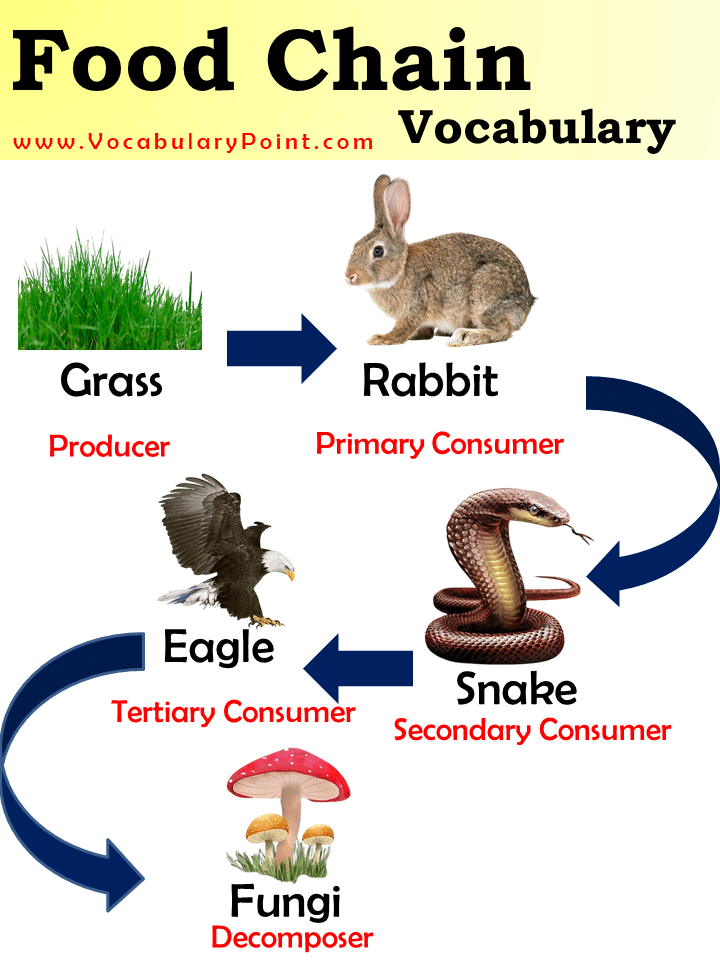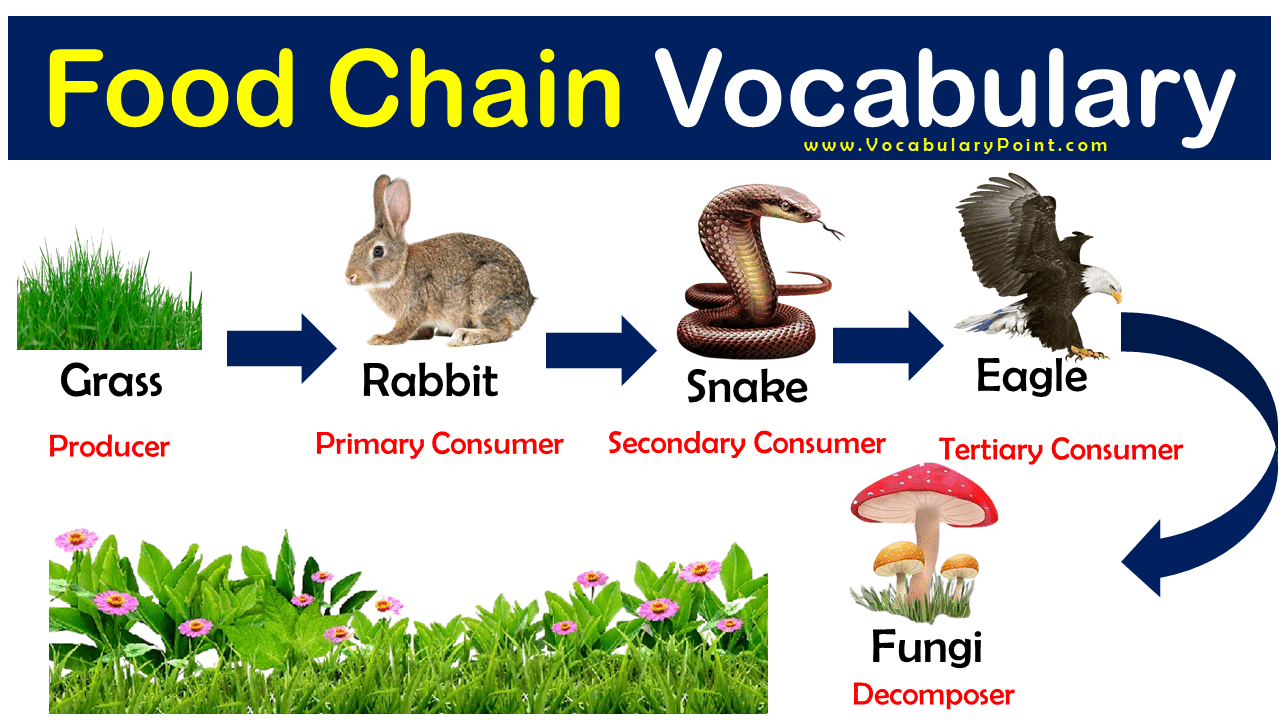Exploring the food chain Vocabulary teaches us how plants and animals rely on each other for survival. It’s like a puzzle where every piece depends on another to complete the picture. From the sun’s energy to the mightiest predator, every part of this chain plays a crucial role.
Our adventure into food chain vocabulary will unlock new words and show how nature’s dining table is set. Get ready to learn how everything in nature is linked, making our world wonderfully balanced.
Food Chain Vocabulary Words
- Autotrophs: Self-feeders that produce food through sunlight or chemicals.
- Heterotrophs: Organisms that eat other organisms for energy.
- Producers: Usually plants, they form the base of the food chain.
- Consumers: Eat other organisms for energy.
- Primary Consumers: Herbivores that eat producers.
- Secondary Consumers: Eat primary consumers.
- Tertiary Consumers: Predators that eat secondary consumers.
- Quaternary Consumers: Top predators, no natural enemies.
- Herbivores: Eat plants or algae.
- Carnivores: Eat other animals.
- Omnivores: Eat both plants and animals.
- Detritivores: Feed on dead organic material.
- Decomposers: Break down dead matter into simpler substances.
- Scavengers: Consume dead animals they didn’t kill.
- Food Chain: Sequence of who eats whom in a biological community.
- Food Web: Complex network of interconnected food chains.
- Trophic Level: Position an organism occupies in a food chain.
- Biomass: Total mass of organisms in a given area.
- Energy Pyramid: Shows energy flow in ecosystems, decreasing at each level.
- Biotic Factors: Living components in an ecosystem.
- Abiotic Factors: Non-living environmental components.
- Ecosystem: Community of living things and their environment.
- Biome: Large area with distinct animal and plant groups.
- Biodiversity: Variety of life in a particular habitat.
- Ecological Niche: A species’ role and position in its environment.
- Symbiosis: Close interaction between different species.
- Mutualism: Symbiotic relationship where both benefit.
- Commensalism: One benefits, the other is unaffected.
- Parasitism: One benefits at the other’s expense.
- Predation: One animal preys on others.
- Competition: Struggle for resources among organisms.
- Keystone Species: Vital for maintaining ecological balance.
- Invasive Species: Non-native species that dominate ecosystems.
- Conservation: Protecting the natural environment.
- Endangered Species: Species at risk of extinction.
- Extinction: The dying out of a species.
- Habitat Destruction: Loss of natural habitats.
- Pollution: Harmful substances in the environment.
- Climate Change: Long-term weather pattern changes.
- Carbon Footprint: Greenhouse gas emission measure.
- Renewable Resources: Naturally replenishable resources.
- Non-renewable Resources: Resources that can’t be quickly replaced.
- Sustainable Development: Development without resource depletion.
- Ecotourism: Tourism to threatened, natural areas.
- Bioaccumulation: Accumulation of substances in an organism.
- Biomagnification: Increase in substance concentration up the food chain.
- Eutrophication: Excessive nutrients in water, causing plant and animal death.
- Acid Rain: Pollution-caused acidic rainfall.
- Deforestation: Clearing of forests for land use.
- Carbon Cycle: Processes of carbon exchange in the environment.
Explore More:

Producer (Autotroph)
Organisms that produce their own food from sunlight or chemical energy, forming the base of a food chain.
Consumer (Heterotroph)
Organisms that cannot produce their own food and need to consume other organisms for energy.
Primary Consumer (Herbivore)
Animals that eat plants directly and are the first level of consumers in the food chain.
Secondary Consumer
Carnivores or omnivores that feed on primary consumers.
Tertiary Consumer
Predators that eat secondary consumers, often at the top of the food chain.
Apex Predator
The top predator in a food chain that is not preyed upon by another species.
Decomposer
Organisms that break down dead or decaying organisms, recycling nutrients back into the ecosystem.
Detritivore
Consumers that feed on dead plant and animal matter, contributing to decomposition.
Food Web
A complex network of interlinked food chains within an ecosystem.
Trophic Level
The position an organism occupies in a food chain, from primary producers to apex predators.
Biomagnification
The increase in concentration of substances, such as pesticides, in the tissues of organisms at higher trophic levels.
Energy Pyramid
A graphical representation showing the flow of energy at different trophic levels in an ecosystem.
Nutrient Cycle
The movement and exchange of organic and inorganic matter back into the production of living matter.
Ecological Efficiency
The efficiency with which energy is transferred from one trophic level to the next.
Carnivore
Animals that feed exclusively on other animals.
Omnivore
Animals that eat both plant and animal materials.
Herbivore
Animals that feed exclusively on plant materials.
Scavenger
Animals that consume dead organisms that have died from causes other than predation.
Predator
An organism that hunts and kills other organisms for food.
Prey
Organisms that are hunted and eaten by predators.
Symbiosis
A close and long-term biological interaction between two different biological organisms.
Mutualism
A type of symbiosis where both organisms benefit from the interaction.
Parasitism
A relationship between species where one organism, the parasite, lives on or in another organism, causing it harm.
Commensalism
A type of symbiosis where one organism benefits and the other is neither helped nor harmed.
Keystone Species
A species that has a disproportionately large effect on its natural environment relative to its abundance.
Biodiversity
The variety of life in the world or in a particular habitat or ecosystem.
Habitat
The natural home or environment of an animal, plant, or other organism.
Niche
The role and position a species has in its environment, including all its interactions with the biotic and abiotic factors.
Biomass
The total mass of organisms in a given area or volume.
Bioaccumulation
The accumulation of substances, such as pesticides, or other chemicals in an organism.
Invasive Species
Species that are not native to a specific location and have a tendency to spread, which is believed to cause damage to the environment, human economy, or human health.
